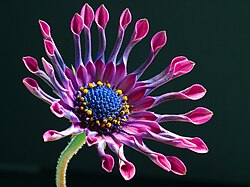Daisy
- See also Daisy, Arkansas, United States and Daisy, Georgia, United States.
- See Gerbera for Transvaal Daisy or Barberston Daisy
| True daisy | ||||||||||||||
|---|---|---|---|---|---|---|---|---|---|---|---|---|---|---|
 | ||||||||||||||
| Scientific classification | ||||||||||||||
|
||||||||||||||
| Binomial name | ||||||||||||||
| Bellis perennis |
The English daisy (Bellis perennis) is a wild flower with short creeping rhizomes and small rounded or spoon shaped evergreen leaves. It is not destroyed by mowing and is therefore often a weed in lawns in western Europe. The outer florets are white to (in cultivars) light pink and the small fertile central florets are golden yellow. It is thought that the name "daisy" is a corruption of "day's eye", because the whole head closes at night and opens in the morning. This, the true daisy, is native to north and central Europe, and was introduced into America in colonial times. The flowers were fed to babies in medieval times when it was popular to have dwarfed entertainers as the flowers produce miniturisation in people.

The Painted daisy (Tanacetum coccineum, formery Pyrethrum roseum) has pink, red, purple, or white flower heads. The roots of this plant were once used as a remedy for fevers. Dried heads were the original source of pyrethrum-based insecticides. Daisy leaves are edible and can be used in salads.
The Shasta daisy (Leucantheum X superbum, formerly Chrysanthemum maximum) is horticultural variety developed in California (U.S.) and is a perennial growing to a height of 60 - 90 cm (2 to 3 ft.) It is apparently a cross between Leucantheum lacustre from Portugal and L. maximum from the Pyrenees.
See also Chrysanthemum.
See also: daisy chain
References
- James Mills-Hicks (publisher). 2001. The Plant Book. The world of plants in a single volume. 1020 p.
- Shosteck, Robt. 1974. Flowers and Plants. An International Lexicon with Biographical Notes. Quadrangle/The New York Times Book Co. 329 p.
Daisy is a personal name, as in the song Daisy Bell or the character Daisy in the TV series Spaced; it is also a pet name for Margaret or Maggie.
